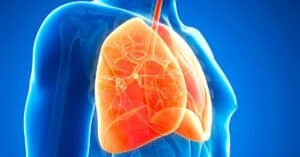Siderosis is a type of occupational lung disease caused by inhaling iron particles through dust or fumes.
Also known as “welder’s lung” or “silver polisher’s lung,” siderosis is a type of pneumoconiosis, which refers more generally to occupational conditions like silicosis, black lung and asbestosis.
It’s also a form of interstitial lung disease; these types of conditions are a result of breathing irritants that settle into the lungs’ airways and air sacs, causing scarring and inflammation over time.
Eventually, the lungs will stiffen and harden, making it difficult to breathe. Because it usually never produces symptoms on its own, siderosis is also known as a benign form of pneumoconiosis.
However, it can result in other conditions with symptoms that worsen and create breathing difficulties, wheezing, coughing and more.
Some evidence points to reduced lung function in those with siderosis, so care must be taken to monitor any symptoms and to receive regular chest x-rays, which can reveal characteristic spots on the lungs.
How do you develop siderosis?
People who develop siderosis usually work in jobs like iron and steel rolling, metal polishing, metal sheet working, mining, soldering, steel-making and welding.
Because of the occupational exposure, those who work around heavy metals and other toxic materials producing dust are encouraged to wear personal protective equipment like special suits and ventilators.
Read More: 7 Ways To Clear Your Lungs After Inhaling Dust
Regular medical checkups can also help detect any early signs of siderosis or lung damage.
Siderosis can’t be cured, and the damage it causes is irreversible.
However, certain treatments may ease the symptoms of the conditions that can stem from siderosis. These include medication like bronchodilators and steroids, oxygen therapy, and pulmonary rehabilitation.

Christine Kingsley, APRN is the Health and Wellness Director at the Lung Institute where she focuses on providing helpful online resources for people looking for information on various lung diseases, breathing exercises, and healthy lifestyle choices. She advocates for holistic care that involves working with your doctor to explore all options including traditional and alternative care while focusing on diet and exercise as proactive measures.









